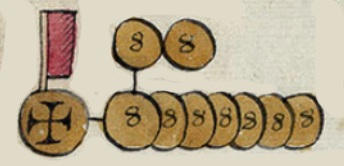cempohualli ipan chiucnahui pesos (CST2)
This is a painting that provides two simplex glyphs for pesos (a loan from Spanish that entered Nahuatl, referring to coins that were also introduced by the colonizers) and the notation for 20 (a -tecpantli glyph of a flag). The glyph shows a frontal view of one peso with a cross on the front and a flag rising vertically at the top of the coin. The flag is a notation that refers to twenty pesos. Attached by lines connecting an additional nine (chiucnahui) pesos to this round number bring the total to 29 (cempohualli ipan chiucnahui). These additional nine are in two groups, the lower horizontal row of seven and, above those, two more. All of these additional nine pesos have the digit 8 on them, because a peso was a “piece of 8,” comprising a value of eight tomines or reales. Thus, these 29 pesos include two simplex glyphs for the word peso, one with a cross and nine marked just by the digit 8.
Stephanie Wood
The peso shown below from the Codex Osuna has a cross like this one. But the Osuna also has a peso with a crown on it. Many signs for pesos in this collection are just filled-in circles, with colors such as black or red. They can also be left as colorless empty circles. For more on the Codex Sierra, see Kevin Terraciano’s study (2021).
Stephanie Wood
1550–1564
Jeff Haskett-Wood
monedas, pesos, veinte-nueve, números

peso, a piece of eight, a Spanish coin and a term introduced into Nahuatl, https://nahuatl.wired-humanities.org/content/peso
cempohualli, twenty, https://nahuatl.wired-humanities.org/content/cempohualli
ipan, plus, https://nahuatl.wired-humanities.org/content/ipan
chiucnahui, nine, https://nahuatl.wired-humanities.org/content/chiucnahui
veintinueve pesos
Stephanie Wood
Codex Sierra-Texupan, plate 2, page dated 1551. Origin: Santa Catalina Texupan, Mixteca Alta, State of Oaxaca. Kevin Terraciano has published an outstanding study of this manuscript (Codex Sierra, 2021), and in his book he refers to alphabetic and “pictorial” writing, not hieroglyphic writing. We are still counting some of the imagery from this source as hieroglyphic writing, but we are also including examples of “iconography” where the images verge on European style illustrations or scenes showing activities. We have this iconography category so that such images can be fruitfully compared with hieroglyphs. Hieroglyphic writing was evolving as a result of the influence of European illustrations, and even alphabetic writing impacted it. https://bidilaf.buap.mx/objeto.xql?id=48281&busqueda=Texupan&action=search
The Biblioteca Digital Lafragua of the Biblioteca Histórica José María Lafragua in Puebla, Mexico, publishes this Códice Sierra-Texupan, 1550–1564 (62pp., 30.7 x 21.8 cm.), referring to it as being in the “Public Domain.” This image is published here under a Creative Commons license, asking that you cite the Biblioteca Digital Lafragua and this Visual Lexicon of Aztec Hieroglyphs.




